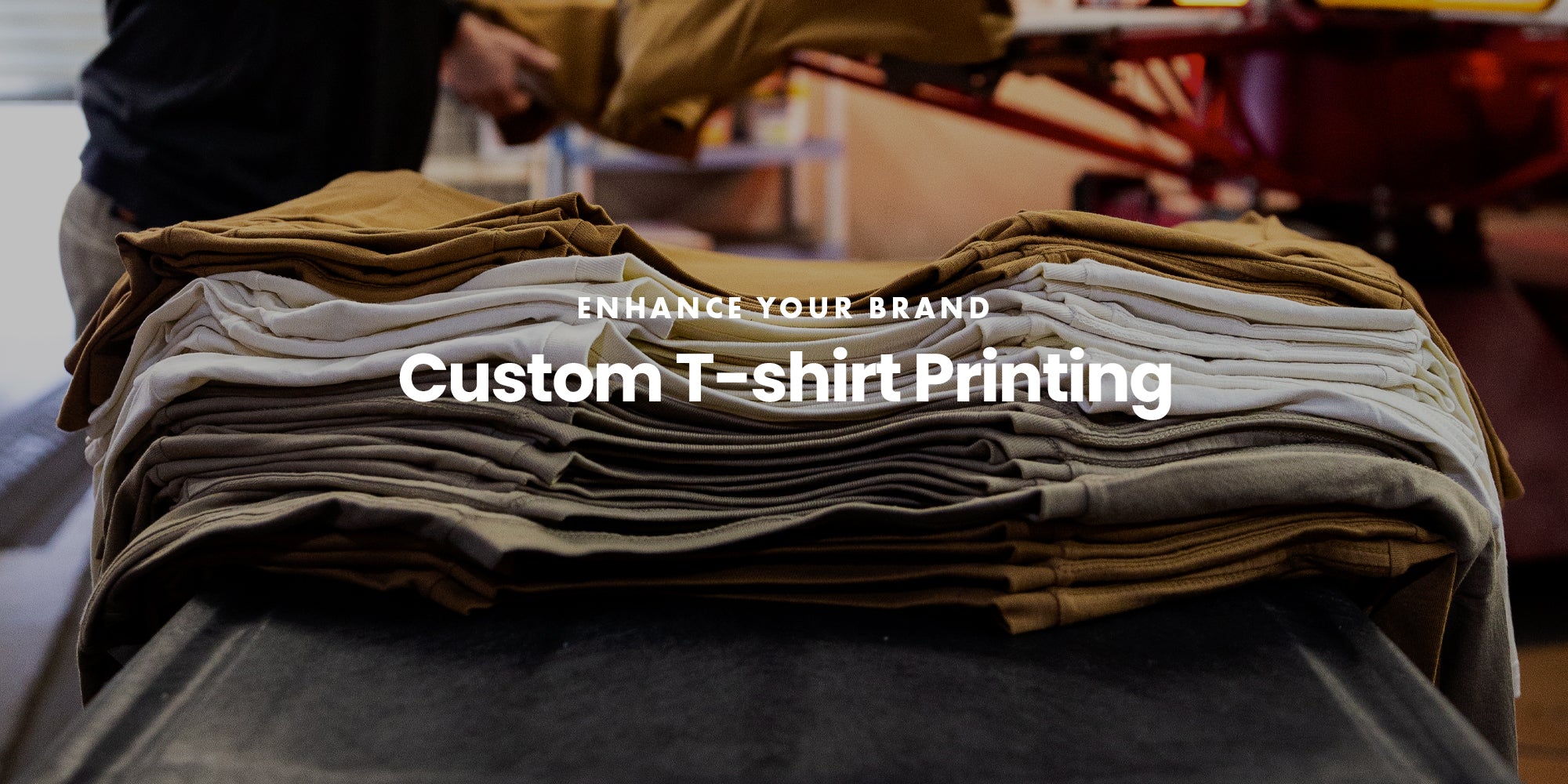Fast Turnaround Custom Screen Printing for Events
Fast Turnaround Custom Screen Printing for Events
Blog Article
Display Printing Uncovered: Everything You Need to Find Out About T-Shirt and Garment Printing Strategies
Display printing is a remarkable technique that incorporates art with strategy, supplying endless possibilities for creativity. Ready to check out the necessary aspects that make display publishing an art type?
The Basics of Screen Printing: Just How It Works
When you dive into screen printing, you'll find it's both an art and a science. At its core, screen printing involves creating a pattern, or display, that permits ink to pass via only in particular locations.
Setting the screen over the textile, then make use of a squeegee to push ink via the screen onto the garment. Each action is necessary, and grasping them will boost your screen printing skills, changing basic garments right into special, expressive pieces.
Kinds Of Display Printing Methods
As soon as you realize the basics of screen printing, it's time to explore the numerous methods that can raise your styles. One popular approach is typical display printing, where ink is pushed through a stenciled display. This strategy is wonderful for strong, vivid colors. There's water-based ink printing, which provides a softer feel and is green, however it requires a various technique to healing.
If you're going for great details, consider discharge printing. This strategy gets rid of color from the material, leaving a soft, classic appearance. One more option is plastisol printing, recognized for its durability and dazzling colors, making it a favorite for several brand names. Ultimately, explore halftone printing to develop gradient effects and detailed styles. Each strategy has its special appeal, so don't think twice to attempt them out to discover what fits your style best!
Essential Equipment for Screen Printing
To achieve sensational cause display printing, having the ideal devices is basic. You'll need a tough screen printing frame, which holds the mesh that transfers your style onto the garment. Next off, buy top notch squeegees; these are crucial for applying ink uniformly across the screen. You'll also require a good exposure unit to create your screens, as well as a washout booth for cleansing them after use. A reliable warmth source, like a conveyor dryer or warm press, is vital for curing your prints to ensure durability. Don't neglect an appropriate office, furnished with tables and storage for your supplies. Safety equipment, such as masks and gloves, will keep you secure from chemicals and inks. With the right devices, you'll be well on your way to creating professional-quality prints.
Choosing the Right Inks and Products
When choosing inks and materials for display printing, you need to take into account the sort of ink that functions finest for your project. Consider fabric compatibility to ensure your styles look last and fantastic lengthy. Additionally, explore environment-friendly ink options to make your printing procedure more sustainable.
Kinds Of Screen Inks
Selecting the best screen ink is important for achieving vibrant, durable prints that fulfill your project's demands. There are numerous types of display inks to examine. Specialty inks, such as glow-in-the-dark or metal, can add special effects to your layouts.

Fabric Compatibility Considerations
Understanding fabric compatibility is vital for accomplishing top quality screen prints, specifically considering that different materials react uniquely to various inks. When picking inks, consider the fabric kind-- cotton, polyester, or blends. For cotton, water-based inks function well, supplying soft qualities and breathability. Polyester, on the various other hand, frequently needs plastisol inks for far better attachment and vivid shades. You could need to utilize a mix of both types if you're printing on blends. Always test your inks on sample textile to assure they stick properly and preserve shade stability. In addition, bear in mind that material weight and texture can influence the last end result, so choosing the ideal ink and material combo is essential for your job's success.
Eco-Friendly Ink Options
Environment-friendly inks are ending up being a popular option for display printers that want to decrease their ecological effect while preserving quality. When picking inks, consider water-based inks, which are much less dangerous and much easier to clean up contrasted to traditional solvents.
Additionally, try to find inks made from renewable energies, such as soy or vegetable-based options. By choosing the best inks and materials, you'll not just produce stunning styles yet also contribute to a much more lasting printing procedure. Make the button, and your prints will show your commitment to the atmosphere!
Preparing Your Design for Screen Printing

Submit Format Needs
To guarantee your style looks lively and sharp on fabric, you'll need to pay very close attention to file layout demands for screen printing. Begin with vector files like AI or EPS, as they can be scaled without shedding high quality. If you make use of raster pictures, go with high-resolution documents, such as TIFF or PNG, preferably at 300 DPI. Avoid making use of JPEGs, as they can lose clarity when resized. Make certain your layout has a clear background to avoid undesirable white sides on your prints. Finally, maintain shade modes in mind; CMYK is basic for display printing, so convert your RGB makes as necessary. By adhering to these guidelines, you'll set your art work up for a successful print.
Shade Separation Techniques
Color splitting up is an important step in preparing your layout for screen printing, and understanding it can substantially improve your print high quality. You'll require to break your design right into private colors, as each color calls for a different display during printing. This accuracy not only guarantees precise shade depiction however likewise streamlines the printing process.
Resolution and Size
Attaining the very best lead to screen printing starts with assuring your layout has the appropriate resolution and dimension. Preferably, your artwork must go to least 300 DPI (dots per inch) for sharp, clear prints. Your final item may look amateur and pixelated. if you use reduced resolution.
When it concerns dimension, Extra resources take into consideration the dimensions of your print location. Design your artwork to match the last print size, ideally producing it Click Here in the real dimensions you'll be printing. This means, you'll avoid any type of unanticipated scaling issues.
Always inspect your design in both vector and raster styles. Vector graphics can be scaled without shedding top quality, making them optimal for display printing. Preparing correctly will ensure your style looks outstanding on every garment!
Step-by-Step Screen Printing Process
Display printing is a dynamic procedure that enables you to create dynamic styles on different surface areas. To get going, you'll require a display, solution, and your chosen ink. Prepare your display by cleaning it completely. Next, use the emulsion uniformly and let it dry in a dark area. As soon as completely dry, expose your display to light with your layout positioned on it, which will solidify the solution where the light hits, creating a pattern - screen printing kit.
Put ink onto the display and utilize a squeegee to press the ink with the pattern onto the textile. Raise the display very carefully and let the print dry. You've efficiently screen printed your layout.
Tips for Successful Screen Printing Projects
While you're diving right into your screen printing tasks, keep in mind that preparation is key to success. Beginning by gathering all your products-- inks, squeegees, screens, and garments. A tidy office aids prevent undesirable mistakes, so clean up before you start.
Next, confirm your art work is high-resolution and properly sized for your garment. Evaluate your screen for proper exposure and tidy it completely to prevent spots. When blending your inks, adhere to the maker's guidelines to attain the best consistency.
During printing, apply also stress with your squeegee for consistent results. Do not rush; take your time to confirm each print fulfills your requirements. After printing, allow your garments completely dry completely prior to taking care of or packaging them.
Last but not least, constantly maintain a sample of your work for blog future referral. In this manner, you can examine your progress and boost your methods in time. Satisfied printing!

Often Asked Inquiries
How much time Does It Require To Establish a Display Printing Job?
Setting up a display printing task usually takes about half an hour to an hour. You'll prepare the screens, mix inks, and adjust the press. The moment varies based upon complexity and experience, so remain arranged!
Can I Publish on Various Textile Types Using the Same Method?
Yes, you can print on various material types utilizing the very same method, yet you'll require to adjust your setups and inks. Some fabrics take in ink in different ways, so experimenting assurances the very best outcomes for each and every product.
What Are Usual Blunders to Prevent in Display Printing?
When display printing, avoid typical blunders like using the incorrect ink, neglecting correct exposure times, or missing pre-press checks. Constantly check your arrangement and preserve clean screens to assure top quality outcomes each time.
Just How Can I Properly Clean and Maintain My Screen Printing Devices?
To effectively clean and preserve your screen printing equipment, you ought to regularly wash displays with suitable solvents, examine mops for wear, and guarantee all devices are saved dust-free and completely dry. Consistency avoids pricey repair work and improves performance.
Is Display Printing Eco-friendly Contrasted to Various Other Techniques?
Display printing can be more eco-friendly than other approaches, particularly if you use water-based inks and eco-conscious materials. By selecting lasting materials and practices, you minimize waste and minimize your influence on the world.
Display Printing Uncovered: Every Little Thing You Required to Know About Tee and Garment Printing Methods
At its core, screen printing includes developing a stencil, or screen, that permits ink to pass via just in certain areas. Setting the screen over the fabric, then make use of a squeegee to press ink via the screen onto the garment. One prominent technique is traditional display printing, where ink is pushed through a stenciled display.When choosing inks and materials for screen printing, you need to take right into account the type of ink that functions ideal for your project.
Report this page